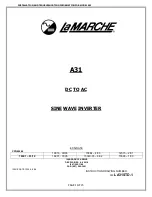
• In case of series/parallel connection disconnect the midpoint, parallel connection wiring and measure the individual midpoint
voltages during absorption charging to isolate batteries or cells which need additional charging.
• Charge and then test all batteries or cells individually.
In case of an older battery bank which has performed well in the past the problem may be due to systematic undercharge. In this
case more frequent charging or an equalization charge is needed. Please note that only flooded deep cycle flat plate or OPzS
batteries can be equalized. Better and regular charging will solve the problem.
In case there are one or more faulty cells:
• In case of series/parallel connection disconnect the midpoint, parallel connection wiring and measure the individual midpoint
voltages during absorption charging to isolate batteries or cells which need additional charging.
• Charge and then test all batteries or cells individually.
9.6. What to do in case of an alarm during discharging
The individual batteries or cells of a battery bank are not identical, and when fully discharging a battery bank, the voltage of some
cells will start dropping earlier than others. The midpoint alarm will therefore nearly always trip at the end of a deep discharge.
If the midpoint alarm trips much earlier (and does not trip during charging), some batteries or cells may have lost capacity or may
have developed a higher internal resistance than others. The battery bank may have reached the end of service life, or one or
more cells or batteries have developed a fault:
• In case of series/parallel connection, disconnect the midpoint parallel connection wiring and measure the individual midpoint
voltages during discharging to isolate faulty batteries or cells.
• Charge and then test all batteries or cells individually.
9.7. The Battery Balancer
A consideration can be made to add a
to the system. A Battery Balancer will equalize the state of charge of two
series connected 12V batteries, or of several parallel strings of series connected batteries.
When the charge voltage of a 24V battery system increases to more than 27.3V, the Battery Balancer will turn on and compare
the voltage over the two series connected batteries. The Battery Balancer will draw a current of up to 0.7A from the battery (or
parallel connected batteries) with the highest voltage. The resulting charge current differential will ensure that all batteries will
converge to the same state of charge. If needed, several balancers can be paralleled.
A 48V battery bank can be balanced with three Battery Balancers, one between each battery.
For more information see the Battery Balancer product page:
https://www.victronenergy.com/batteries/battery-balancer
.
Manual - SmartShunt IP65
Page 35
Midpoint voltage monitoring









































